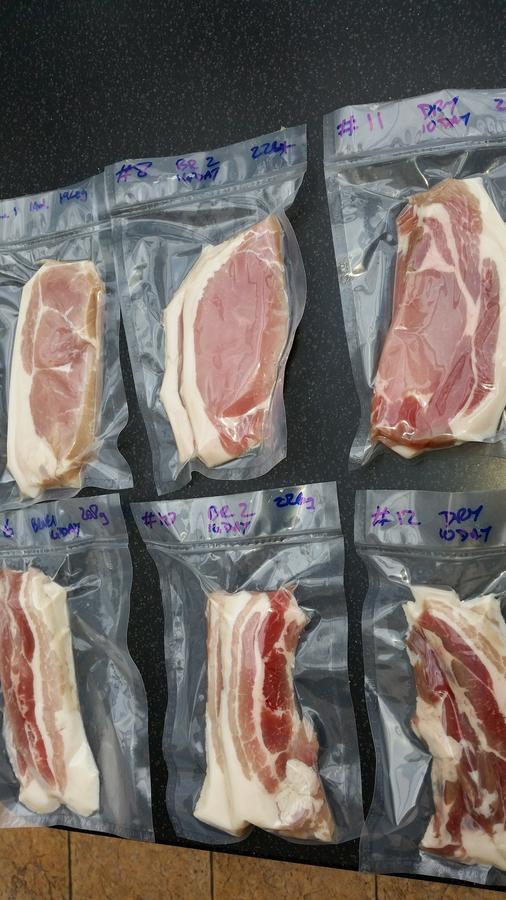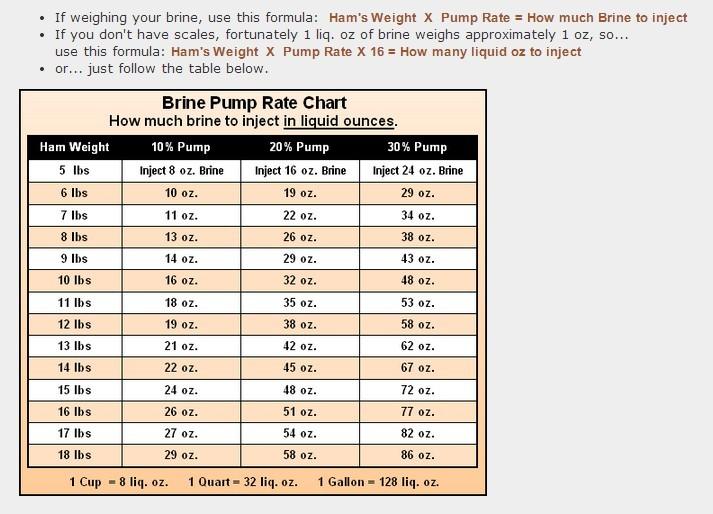In response to curing questions on ppm, here is the FSIS explanation:
Here is the way to calculate PPM:
*USDA Processing Inspectors' Calculations Handbook, page 7: Nitrite x 10% pump x 1,000,000 / weight of brine = ppm
First you need to find out how much Sodium Nitrite is in a specific amount of Cure. Let's say that we want to use 3oz of
InstaCure#1. You have to find what 3 oz is in LBS, this is done by dividing 3 by 16 (because there are 16 ozs in a pound),
this comes to 0.1875 lbs.
Cure #1 has 6.25% Sodium Nitrite. So, to find out how much Nitrite is in that 0.1875 lbs of Cure, multiply 0.1875 by that
percentage as a decimal… 0.1875 x 0.0625 = 0.01171 lbs Sodium Nitrite in 3 oz Cure.
The ‘weight of brine’ is simply how heavy the water/brine is… One gallon of water weighs approximately 8.33 lbs.
Now to find the Parts Per Million (ppm), here is the formula:
multiply nitrites by % pump by 1,000,000 and DIVIDE it by the weight of your brine.
Here is the ppm formula for 3 oz Cure#1:
Nitrite x 10% pump x 1,000,000 / weight of brine = parts per million
0.01171 x 0.10 x 1,000,000 / 8.33 = ppm
0.001171 x 1,000,000 / 8.33 = ppm
1171 / 8.33 = ppm
140 ppm nitrite in 1 gallon of water when using 3 oz of Cure#1.
My brine is considerably lower, 1/3rd as much. My dad argued, and won, with the State of NY Meat Inspection that his lower nitrite brine was safe and effective when left to cure longer and would produce a more tender, more flavorful, product and was allowed to continue for 40 years.
For the Metric side of the world:
*USDA Processing Inspectors' Calculations Handbook, page 7:
Nitrite x 10% pump x 1,000,000 / weight of brine = ppm
First, you need to find out how much Sodium Nitrite is in a specific amount of Cure.
Let's say that we want to use 85g of InstaCure#1. InstaCure #1 has 6.25% Sodium Nitrite.
So, to find out how much Nitrite is in that 85 grams of Cure, multiply 85 by 6.25% as a decimal… 85 x 0.0625 = 5.3125g Sodium Nitrite in 85g Cure.
The ‘weight of brine’ is simply how heavy the water/brine is… One gallon (3.78 l) of water weighs approximately 3,778g.
Now to find the Parts Per Million (ppm), here is the formula: multiply nitrites by % pump by 1,000,000 and DIVIDE it by the weight of your brine.
Here is the ppm formula for 85g Cure#1:
Nitrite x 10% pump x 1,000,000 / weight of brine = parts per million 5.3125 x 0.10 x 1,000,000 / 3,778 = ppm 0.53125 x 1,000,000 / 3,778 = ppm 531,250 / 3,778 = ppm
140 ppm nitrite in 1 gallon (3.78 l) of water when using 85 grams of Cure#1.







